
| Intro | Speech contest | Pizza delivery | Osechi foods | Gallery show | Marble house | Kamakura | Bonenkai | Bonenkai 2 | Emperor | Sapporo | Walking | Hanami | Visitors | Skiing | 7 Lucky gods | Visitor's survival guide | Kasuga |
sapporo ni ikimashita
May 22-23, 1999
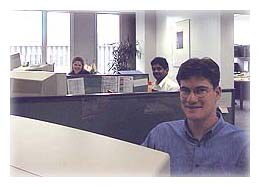 Work has reached its peak frenzy for me--by
the end of June my team and I will have ushered sixteen more programs through the
test centre for a total of 59 and all of the bank's critical applications will be
certified year 2000 compliant. There are multi-bank "street tests" almost every
weekend this month and all the development teams who came into the project
"behind the curve" are rushing to meet the June 30 regulatory deadline. Plus,
we're training our replacements!
Work has reached its peak frenzy for me--by
the end of June my team and I will have ushered sixteen more programs through the
test centre for a total of 59 and all of the bank's critical applications will be
certified year 2000 compliant. There are multi-bank "street tests" almost every
weekend this month and all the development teams who came into the project
"behind the curve" are rushing to meet the June 30 regulatory deadline. Plus,
we're training our replacements!
So in the calm before the storm and to celebrate my last free weekend until July, Tod & I took a trip to Sapporo on the northern island of Hokkaido.
We left work on Friday night and flew out of Haneda airport which is much closer to Tokyo than its big sister, Narita. We arrived in Sapporo at 9:30 and made our way to our hotel.
We stayed at a traditional Japanese ryokan hotel, called Nakamuraya right in the city. We had an 18-jo room, which is giagantic by Japanese standards. There was a room with tatami mat flooring and a low Japanese dining table, a separate tatami room for our futon beds which included the traditional alcove bound on one side by a natural wood post, and an enclosed porch with a western style coffee table and chairs. All of the rooms could be closed off with sliding panels that were covered in silk printed with a scattering of snowflake patterns near the bottom.
 Ryokan include breakfast and dinner in the
price of the room. We arrived too late for dinner on the first night, but on the
second night of our stay it was served in our room on the low table. The
kimono-clad hostess brought in dish after tiny dish and laid them out. When she
was finished there were ten dishes apiece for Tod & I. Slices of sashimi, a
stuffed baby squid no more than two inches long, a tiny slab of egg custard, tofu
cut into pretty shapes, fish paste wrapped in a leaf, miso soup, myriad pickled
vegetables topped with decorative reproductive fish parts and flowers. Each bit
had its own dish or shared a
rectangular platter with one or two other artfully arranged items.
Ryokan include breakfast and dinner in the
price of the room. We arrived too late for dinner on the first night, but on the
second night of our stay it was served in our room on the low table. The
kimono-clad hostess brought in dish after tiny dish and laid them out. When she
was finished there were ten dishes apiece for Tod & I. Slices of sashimi, a
stuffed baby squid no more than two inches long, a tiny slab of egg custard, tofu
cut into pretty shapes, fish paste wrapped in a leaf, miso soup, myriad pickled
vegetables topped with decorative reproductive fish parts and flowers. Each bit
had its own dish or shared a
rectangular platter with one or two other artfully arranged items.
The ryokan also had, as most do, a public bath. There is nothing nicer after a long flight or a day of sightseeing than scubbing down at the tap and then stepping into the scalding water for a soak. This bath was not large, perhaps three or four people at a time would easily fit, but I shared it only with one other or had it to myself each time I bathed.
And all of this pleasure and fun was only the place we stayed at night. We filled two days with the sights of Sapporo.
We happened to arrive on the weekend of the Lilac Festival, so the centre of town which is a long park called Odori Koen was abuzz with activity and the entire town smelled of lilacs. On Saturday morning, we ascended the TV Tower at the end of the park (you know we can't resist getting to the top of a tall thing) and while Tod reviewed the history of Sapporo in photos and text, I snapped some photos. We went down and listened to a school band playing "Smooth Operator" with each instrument getting its turn at a solo while we consulted the giant map near the tower. It was the only map in English we saw while we were there.

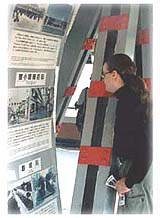

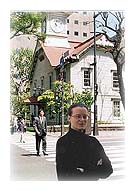 After deciding on a plan for the day, we
wandered over to the clock tower, which had been a military drill hall of the
agricultural college that was founded in Sapporo in the 1870s. Hokkaido is still
Japan's agricultural centre--corn, potatoes, and most of Japan's fresh dairy
products come from Hokkaido. The agricultural college boosted Hokkaido's
productivity and the clock tower stands as a respected memorial of that early
institution. The museum in the building was fascinating--a look at a very tiny
slice of Sapporo history.
After deciding on a plan for the day, we
wandered over to the clock tower, which had been a military drill hall of the
agricultural college that was founded in Sapporo in the 1870s. Hokkaido is still
Japan's agricultural centre--corn, potatoes, and most of Japan's fresh dairy
products come from Hokkaido. The agricultural college boosted Hokkaido's
productivity and the clock tower stands as a respected memorial of that early
institution. The museum in the building was fascinating--a look at a very tiny
slice of Sapporo history.
The museum finished, we decided to head out of the city to another unusual
museum--the Living Museum of Salmon. At the end of the subway line, we found
ourselves deposited in suburban Sapporo. We bought a picnic lunch at a
supermarket and wandered towards the museum through a park that had been one of
the Olympic sites in 1972. While I stood outside the Olympic skating rink
demonstrating the effect of arms up and arms down on cetripetal force, Tod
snapped my photo.
The salmon museum was small and free and air conditioned--all of which added up to a very pleasant hour. We examined the exhibits (and learned some new words of Japanese through context), watched salmon and other local fish in various stages of growth swimming in breeding tanks and we stuck around while the naturalist fed crickets to the frogs & turtles in the terrariums. I think we enjoyed it as much as the little kids--maybe more since they seemed to be slightly alarmed by our strange round eyes and odd language.
Finished with the salmon museum and the park, we decided to hike up the subway line (which is actually elevated and covered outside of downtown Sapporo) to the stop before the end of the line where we alighted. It turned out to be a longer walk than we'd bargained for, but we saw some nice residential areas and a military base or maybe a national guard reserve training area. People jogging around a track, a tank or two in the background...
We had one more museum on our agenda back in town and near our hotel, the Sapporo Museum of Modern Art. There was an exhibit of Noh masks, along with a video of the master artist at work arving them. A facinating process. The masks on display had all been used in Noh dramas and they ranged from young girls to ugly old men and from evil demons to cheery gods.
After all the touring, it was time to return to the hotel for a hot soak in the bath before the luxury of dinner in our room as described above. Then, with full bellies, we crawled into our futons and fell fast asleep.
Breakfast in Japan is another multi-dish extravaganza. The standard Japanese breakfast is a bowl of rice, a raw egg to pour over the rice, sheets of seaweed paper to pick up fingerfuls of the egg-coated rice , a small slab of cured salmon, salty, pickled vegetables, miso soup and green tea. In addition to this, we had free rein at the Viking (Japanese code for "all you can eat") buffet table which included scrambled eggs, sausage, bacon, more pickled vegetables, and fruit. Gochiso sama deshita! (It was a feast!)
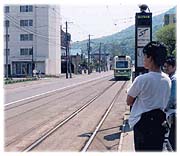 We waddled out of the hotel and towards the train to Mt Moriwa. Or we thought
we were heading in the right direction. But when we couldn't find the station, we
stopped to ask a policeman who was guarding the street for the Lilac Festival
10K. The policeman spoke very little English-Tod commented that this was the
first time that our Japanese was better than someone's English. And it was true.
We understood his directions in Japanese with no problem and got to the station.
We waddled out of the hotel and towards the train to Mt Moriwa. Or we thought
we were heading in the right direction. But when we couldn't find the station, we
stopped to ask a policeman who was guarding the street for the Lilac Festival
10K. The policeman spoke very little English-Tod commented that this was the
first time that our Japanese was better than someone's English. And it was true.
We understood his directions in Japanese with no problem and got to the station.
The train was an old-fashioned street car and the station was just a tiny island in the street. The ride was scenic and we were deposited at the foot of Mt. Moriwa. A short, steep walk later, we were buying our tickets for the various transports to the top of the mountain. We boarded a cable car along with two dozen bus tour participants and were carried up above the city. There were some lovely views of the buildings and a cemetery below.
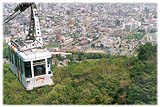
 At the top of
the cable car was a ski-lift to make the final ascent to the summit. It was a
very low ski-lift. There were places when my feet skimmed the grass! Tod had
never been on a lift or a cable car and he enjoyed the rides.
At the top of
the cable car was a ski-lift to make the final ascent to the summit. It was a
very low ski-lift. There were places when my feet skimmed the grass! Tod had
never been on a lift or a cable car and he enjoyed the rides.
 Mt. Moriwa is not a huge mountain by any means.
But it does have an impressive view of the city. We never fail to be amused the
typical landmark scenes at every tourist destination in Japan--people clustered
around the vending machines and crowded into the shops buying omiyage to take
home--and the top of Mt. Moriwa was no exception. We followed the crowd and
bought some candy and a few trinkets for friends back home. We tried to call our
friend Mike (it was his birthday), but Tod's cell phone wasn't co-operating.
Mt. Moriwa is not a huge mountain by any means.
But it does have an impressive view of the city. We never fail to be amused the
typical landmark scenes at every tourist destination in Japan--people clustered
around the vending machines and crowded into the shops buying omiyage to take
home--and the top of Mt. Moriwa was no exception. We followed the crowd and
bought some candy and a few trinkets for friends back home. We tried to call our
friend Mike (it was his birthday), but Tod's cell phone wasn't co-operating.
We rode the lift back down to the cable car and while I sketched for a few minutes, Tod found a shady spot with some left over snow! Another cable car ride and a streetcar later and we were back in the city.
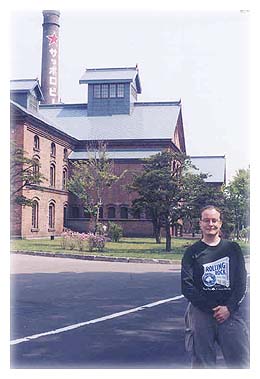 But not for long; our next destination was the
Sapporo Beer Garden and Museum. The buses confused us, but we did find the
correct one after a short wander around the bus terminal. We were starving by
this time. You'd think that our hearty breakfast would have lasted all day, but
by 2:00 it was lunchtime.
But not for long; our next destination was the
Sapporo Beer Garden and Museum. The buses confused us, but we did find the
correct one after a short wander around the bus terminal. We were starving by
this time. You'd think that our hearty breakfast would have lasted all day, but
by 2:00 it was lunchtime.
The beer garden offers Viking Ghengis Khan and beer (Sapporo, of course). Ghengis Kahn is a platter of raw lamb slices and vegetables which you cook to your liking on a cast iron hot plate called a nabe. There a clear sauce to dip the meat into. It's quite delicious and the more beer you swill the better the food is. Actually, I stopped after two beers and switched to ginger ale. Even so, the rest of the afternoon was a little blurry.
We finished three platters of meat and vegetables before we left the beer garden for the museum. We were a few minutes late for the last tour of the day, but we caught up to them in front of the bottling exhibit.
We knew to not to expect an English tour and figured we'd understand 10 or 20 percent of the Japanese narration. We were in for a surprise. The Sapporo guide girl, dressed in a cute red uniform with a little red straw hat, spoke a few sentences and then stopped. A young man dressed in a polo shirt and jeans very enthusiastically started talking to the assembled crowd. But he wasn't speaking Japanese. We had joined a Taiwanese tour group, as Tod discovered when he asked the Sapporo guide. A few of the Taiwanese tourists spoke some English and Tod chatted with them for a little while.
The tour, despite the linguistic difficulties, was interesting and at the end there was a beer tasting room. So on top of the Viking beer from lunch, we poured another one (well, Tod had two).
We spent our last hour in Sapporo the giant Sapporo Factory shopping mall which was a converted brewhouse. It was crammed with American and European stores you'd probably recognise. We bought some tofu doughnuts at Mr. Donut and caught the train to the airport.
The flight home was brief and unremarkable though we did congratulate ourselves on the purchase of doughnuts, as they became our dinner.